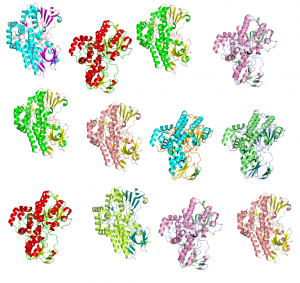A major challenge in modern biology is the discovery of in vivo metabolic or physiological functions of unknown proteins. Our institute has developed an
integrated strategy based on in silico prediction of enzymatic activities and in vitro screening of enzymes [1]. As part of this strategy, our team uses structural bioinformatics (i.e. molecular modeling) to support, drive and interpret experiments.
Thanks to the recent advances in structural biology, three-dimensional structures of many proteins are now available. This has opened up opportunities to study a broad class of enzymes. Molecular modeling has enhanced experimental studies in our institute over the last few years. For instance, homology modeling also explained at molecular level a new regioselectivity of ?-ketoglutarate-dependent amino-acid dioxygenases [2]. On a much larger scale, structural classification of active sites, using a home made software [3], of entire enzyme families has driven the suggestion of 3D-patterns for the annotation of sequences in the Beta Keto Acid Cleavage Enzymes family (BKACE) [1]. It has also conducted site-directed mutagenesis experiments in order to change substrate specificity and suggest annotation rules for function prediction of thousands of enzymes involved in the methionine biosynthesis pathway [5]. Docking of small molecules allowed us to verify the catalytic mechanism hypothesis of an unusual claisen-type condensation [2].
People: Karine Bastard
Collaboration in the Institute:
- Marcel Salanoubat, Alain Perret from the Laboratory of “Génomique et Biochimie du Métabolisme” (LGBM)
- Véronique de Bérardinis, Thomas Bessonnet from the Laboratory of “Clonage et criblage des activités de bioconversions” (LCAB)
- Anne Zaparucha, Carine Vergne, Ombeline Mayol from the Laboratory of Organic Chemistry and Biocatalysis (LCOB)
Related publications :
[1] Bastard K, Smith AA, Vergne-Vaxelaire C, Perret A, Zaparucha A, De Melo-Minardi R, Mariage A, Boutard M, Debard A, Lechaplais C, Pelle C, Pellouin V, Perchat N, Petit JL, Kreimeyer A, Medigue C, Weissenbach J, Artiguenave F, De Berardinis V, Vallenet D, Salanoubat M. Revealing the hidden functional diversity of an enzyme family. Nat Chem Biol. 2014. 10(1):42-9.
[2] In preparation.
[3] de Melo-Minardi RC, Bastard K, Artiguenave F. Identification of subfamily-specific sites based on active sites modeling and clustering. Bioinformatics. 2010. 26(24):3075-82.
[4] Bastard K, Perret A, Mariage A, Bessonnet T, Pinet-Turpault A, Petit JL, Darii E, Bazire P, Vergne-Vaxelaire C, Brewee C, Debard A, Pellouin V, Besnard-Gonnet M, Artiguenave F, Médigue C, Vallenet D, Danchin A, Zaparucha A, Weissenbach J, Salanoubat M, de Berardinis V. Parallel evolution of non-homologous isofunctional enzymes in methionine biosynthesis. Nat Chem Biol. 2017 Jun 5. doi: 10.1038/nchembio.2397.
[5] Bellinzoni M, Bastard K, Perret A, Zaparucha A, Perchat N, Vergne C, Wagner T, de Melo-Minardi RC, Artiguenave F, Cohen GN, Weissenbach J, Salanoubat M, Alzari PM. 3-Keto-5-aminohexanoate cleavage enzyme: a common fold for an uncommon Claisen-type condensation. J Biol Chem. 2011. 286(31):27399-405.

